

Centre for Excellence in Learning and Teaching. What is an inclusive curriculum?
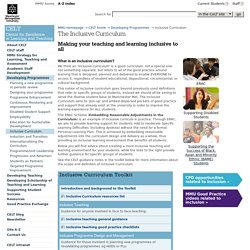
We think an ‘Inclusive curriculum’ is a good curriculum, not a special one, not something separate, but refers to all of the good practice around learning that is designed, planned and delivered to enable EVERYONE to access it, regardless of student educational, dispositional, circumstantial, or cultural background. This notion of inclusive curriculum goes beyond previously used definitions that refer to specific groups of students; instead we should all be aiming to serve the diverse student base at Manchester Met. JISC - Enhancing staff support for learners with disabilities. Training for all staff should include more than just disability awareness.
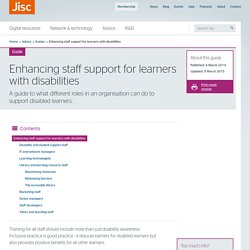
Inclusive practice is good practice - it reduces barriers for disabled learners but also provides positive benefits for all other learners. Providing training and ongoing support for teaching staff will enable them to become more confident in using technology to enhance and enrich their practice. If the technology is deployed across the organisation, and there is a commitment to promote its use, then there needs to be staff training as part of the induction process. We also recommend tutorials be made available so that people can access them at a time and situation that is convenient for them. This guide looks at specific areas to develop for the different roles in an organisation. You can also find information on specific disabilities and how technology can support those needs in our guide on 'Meeting the requirements of learners with special educational needs.'
JISC - Using assistive and accessible technology in teaching and learning. University of Sheffield - The inclusive learning and teaching handbook. Univeristy of Birmingham Inclusive Learning and Teaching: Teaching Academy. The Embedding Equality and Diversity in the Curriculum (EEDC) project is funded by the Scottish Funding Council (SFC) to offer support to Scottish HEIs in the context of the increasing diversity of the student body and strengthening of legislative duties to proactively promote equality, eliminate discrimination and foster good relations.
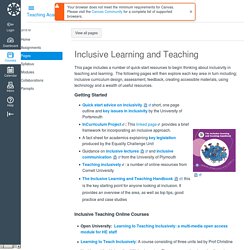
All of this calls for a re-examination of the management, design and delivery of learning, teaching and assessment so as to incorporate (rather than add on) equality and diversity. We support EEDC through engagement with HEIs, the commissioning of research, the production of frameworks and toolkits and the curating of resources.
Resources This page includes a number of quick-start resources to begin thinking about inclusivity in teaching and learning. The following pages will then explore each key area in turn including; inclusive curriculum design, assessment, feedback, creating accessible materials, using technology and a wealth of useful resources. Transforming teaching in higher education - making it inclusive. Transforming teaching in higher education - making it inclusive Submitting Institution University of Wolverhampton Unit of Assessment Education Summary Impact Type Societal.
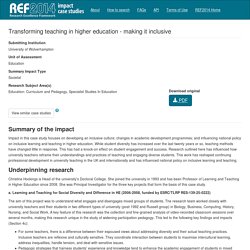
JISC - Supporting an inclusive learner experience in higher education. Introduction The number of disabled learners entering higher education (HE) is trending steadily upwards as barriers to participation and achievement are reduced.
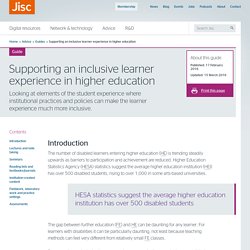
Higher Education Statistics Agency (HESA) statistics suggest the average higher education institution (HEI) has over 500 disabled students, rising to over 1,000 in some arts-based universities. The gap between further education (FE) and HE can be daunting for any learner. For learners with disabilities it can be particularly daunting, not least because teaching methods can feel very different from relatively small FE classes. By supporting an inclusive learner experience, organisations can better serve all their learners at the same time as significantly reducing barriers for disabled students. Pymouth University - Inclusive teaching and learning research. There is a large body of research about inclusive practice in higher education.
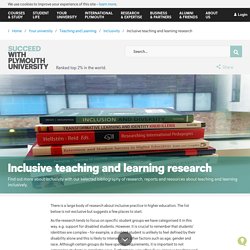
The list below is not exclusive but suggests a few places to start. As the research tends to focus on specific student groups we have categorised it in this way, e.g. support for disabled students. However, it is crucial to remember that students’ identities are complex – for example, a disabled student is unlikely to feel defined by their disability alone and this is likely to intersect with other factors such as age, gender and race. Oxford Brookes University - Guide to inclusive teaching. Equality Challenge Unit Inclusive learning and teaching. Inclusive learning and teaching in higher education - Final Report. A review of ‘Inclusive learning and teaching in higher education: a synthesis of research’ Hockings, C. (2010) Inclusive learning and teaching in higher education: a synthesis of research.

Higher Education Academy, York. This is a 67-page document which collects together and seeks links between ‘a small number of publicly funded studies that address issues of inclusive learning and teaching in HE, either directly or indirectly’ (p.4). The studies are, with one exception, ‘based on primary or empirical data’; almost all are UK-based. As such, they provide a way for the reader to gain access to a significant body of work, to get a sense of what is in them and to benefit from the author’s (clearly longstanding) knowledge of the topic of inclusive learning and teaching. Professor Hockings calls this a ‘synthesis’ and lives up to the claim: it is much more than a collection. Inclusive learning and teaching in higher education: a synthesis of research. Preparing teachers for inclusive education: using inclusive pedagogy to enhance teaching and learning for all.
Making a difference—inclusive learning and teaching in higher education through open educational resources. Inclusive learning and teaching. Teaching a diverse student body – a proposed tool for lecturers to self-evaluate their approach to inclusive teaching. By Sheila Cunningham Abstract Higher education moved from elite to a mass system in England over the last two decades under New Labour’s policy of developing social mobility and knowledge economy.

As participation in HE almost reached the target 50% it resulted in greater diversity and associated demands on institutions of the needs of diverse students. The increasing need for university lecturers to be cognisant of and responsive to such diversity is increasingly important. Research indicates that lecturers who practice inclusively benefit all students’ not just specific groups yet there remains variable practice in some areas a dissonance between espoused versus actual practice for inclusive teaching.
Publisher: Open Journals System Year: 2013 OAI identifier: oai:eprints.mdx.ac.uk:11029 Recommendations Citations (2007). If you think this content is not provided as Open Access according to the BOAI definition then please contact us immediately. Inclusive technologies and learning:research, practice and policy. By Donald Passey Abstract This special issue focuses on an important contemporary concern—inclusive technologies and learning.

Since the 1960s there has been a continued development and diversification of digital technologies used across societal sectors (Bijker, Hughes, Pinch, & Douglas, 2012), enabling applications not solely within business and commerce, but significantly within educational and social settings (such as the technology rangesthose discussed by The Metiri Group, 2006, for example), supporting communication and learning (shown, for example, shown by Richardson, 2012), providing opportunities to widen and deepen reach and interactions (as indicated, for example, by Kim, Hagashi, Carillo, Gonzales, Makany, Lee, & Gàrate, 2011).
Inclusive Education: Enhancing the student experience through simple learning technologies. By NA Hall and F Velez-Colby Topics: media_dig_tech_and_creative_econ OAI identifier: oai:usir.salford.ac.uk:17005 Recommendations Teaching a Dyslexic Student: A Personal View how Critical Incident Analysis can be used as an Effective Pedagogical Tool in Undergraduate Biosciences Provided by: ROAR at University of East London By Ahluwalia Jatinder Additional help, additional problem – issues for supported dyslexic students\ud Provided by: Open Research Online By Robson Linda MELEES - e-support or mayhem?

Perspectives on inclusive education: learning from each other. By Kieron Sheehy, Jonathan Rix, Melanie Nind and Katy Simmons Abstract Many courses of study are currently available that address inclusive education and, increasingly, distance education is seen as a flexible and appropriately inclusive way to deliver sure courses. In this article a tem of colleagues discuss the development of an Open University course, E243 Inclusive Education: Learning from Each Other, which was launched in February 2004. The team reflects on their own process of learning from each other and from the rich network of people involved, mirroring some of the course themes in their own journeys.
Collaborative learning became a key theme within the course, both as a method for teaching within the 'inclusive classroom' and also as the process for producing a course in a contested and challenging area. Adapting e-learning and learning services for people with disabilities. By Christopher Douce, Wendy Porch and Martyn Cooper Abstract Providing learning materials and support services that are adapted to the needs of individuals has the potential to enable learners to obtain maximal benefit from university level studies.
This paper describes EU4ALL project which has been exploring how to present customized learning materials and services for people with disabilities. A number of the technical components of the EU4ALL framework are described. This is followed with a brief description of prototype implementations. OAI identifier: oai:open.ac.uk.OAI2:24935 Recommendations. Holistic vision for creating accessible services based on MOOCs. By Covadonga Rodrigo and Francisco Iniesto Abstract MOOCs are examples of the evolution of eLearning environments towards more a revolutionary computer and mobile-based scenario along with social technologies that will lead to the emergence of new kinds of learning applications that enhance communication and collaboration processes. The flexibility of the learning service students to learn at their own time, place and pace, enhancing continuous communication and interaction between all participants in knowledge and community building, especially benefits people with disabilities and therefore can improve their level of employability and social inclusion.
\ud However, the access to MOOC platforms still present barriers, there is also a lack of accessibility on the learning resources, the communicating tools and even personalized user interfaces. OAI identifier: oai:open.ac.uk.OAI2:45194. Using accessible digital resources for teaching database design: towards an inclusive distance learning proposal. By Lourdes Moreno, Ana Iglesias, Elena Castro and Paloma Martínez Abstract [Proceedings of] 13th Annual Conference on Innovation and Technology in Computer Science Education (ITiCSE'08), Madrid, Spain, June 30-July 2, 2008This paper introduces a pilot experience in teaching database using accessible digital resources in 3er course of Computer Science degree at Universidad Carlos III de Madrid. A platform containing learning material in different formats (video, audio, slides presentation) has been designed allowing students accessing resources as well as to be evaluated by means of tests.
Preliminary results show that 46.81% of the students have already interacted with the system and 97.12% of the students passed the tests.Publicad. Creating inclusive online teaching and learning practices in Desire2Learn units and courses. By Leanne Ngo, Mary O\u27Sullivan and Zofia Pawlaczek. Making the transition: disabled students in Higher Education. By Janet Hargreaves, Lizzie Walker, Berenice Golding, K. State, Jon Blacktop, Phyllis Isobel Fletcher-Cook, Keith Hickling and David G Arthurs. Teaching and Assessment can be inclusive too.
By Jackie Lane Abstract. Developing inclusive technical capital beyond the disabled students’ allowance in England. Not the right kind of ‘digital capital’? An examination of the complex relationship between disabled students, their technologies and higher education institutions. Towards socially inclusive teaching and learning in higher education. Inclusive technologies and learning. Curriculum and Pedagogy in Inclusive Education. How might inclusive approaches to assessment enhance student learning in HE? Butcher, John; Sedgwick, Paul; Lazard, Lisa and Hey, Jayne (2010). Enhancing the Learner Experience in Higher Education, 2(1) pp. 25–40.